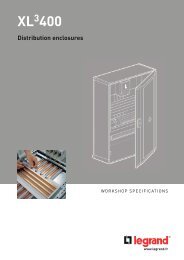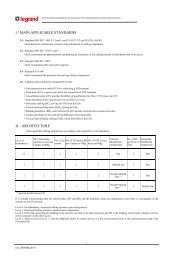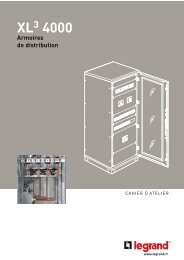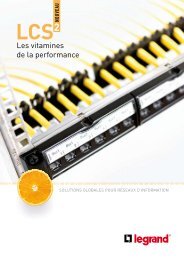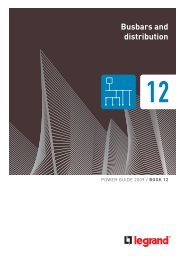Download - legrand
Download - legrand
Download - legrand
Create successful ePaper yourself
Turn your PDF publications into a flip-book with our unique Google optimized e-Paper software.
POWER FACTOR<br />
By definition, the power factor, or the Cos ø, of an<br />
electrical device is equal to the active power P (kW)<br />
over the apparent power S (kVA), and can vary from<br />
0 to 1.<br />
cos ø =<br />
P (kW)<br />
S (kVA)<br />
It thus enables the reactive energy consumption level<br />
of devices to be easily identified.<br />
A power factor of 1 will result in no reactive energy<br />
consumption (resistance)<br />
A power factor of less than 1 will lead to reactive<br />
energy consumption which increases the closer it is<br />
to 0 (inductance)<br />
Calculation of the tg ø<br />
Er (kVArh)<br />
tg ø =<br />
Ea (kWh)<br />
The tg ø is the ratio between the reactive energy<br />
Er (kVArh) and the active energy Ea (kWh) consumed<br />
during the same period.<br />
Unlike the cos ø, it is easy to see that the tg ø must<br />
be as small as possible in order to have the minimum<br />
reactive energy consumption.<br />
Cos ø and tg ø are linked by the following equation:<br />
1<br />
cos ø =<br />
1 + (tg ø) 2<br />
GENERAL INFORMATION<br />
In an electrical installation, the power factor could<br />
vary from one workshop to another depending on the<br />
equipment installed and the way it is used (off-load,<br />
full load operation, etc.).<br />
Energy metering devices record active and reactive<br />
energy consumption. Electricity suppliers generally<br />
show the term tg ø on their bills.<br />
But it is simpler to refer to a conversion table as on<br />
page 12.<br />
7



